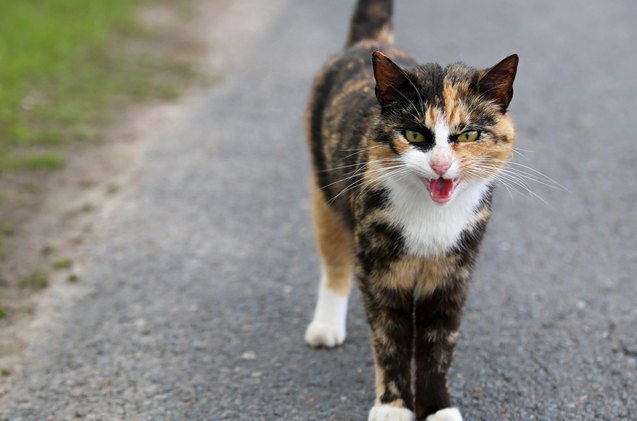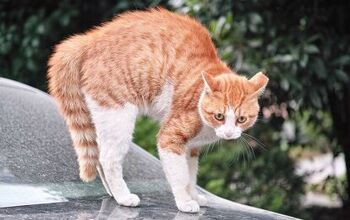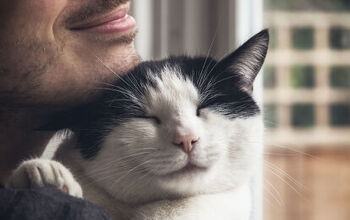How To Understand Cat Body Language

Cats can definitely be hard to read because, unlike dogs, they don’t give off the same physical and vocal clues to let you know what they’re thinking. Instead, when it comes to deciphering what’s going on in the feline mind, you have to really analyze cat body language and vocalizations closely. Below are just a few starting points to understanding cats and what they’re trying to tell you, but keep in mind that every cat is an individual and really getting to know your furry friend will be the best way to comprehend her needs.
Mood: Relaxed
If your cat is in a relaxed mood, her whiskers will typically be forward, both of her ears will be perked up and facing forward, and she may have her paws tucked into her. Other cat body language signs of being completely at ease and relaxed include giving you a soft blink (you may have seen Jackson Galaxy use this tactic on the television series, My Cat from Hell), kneading, rubbing her head on you, or simply lying or sitting in a relaxed posture rather than being ready to dart off or attack. In terms of vocalizations, your cat will probably give an adorably inquisitive sounding “meow,” or she may be purring.
Related: 5 Big Differences Between Cats and Dogs
Mood: Nervous and Unsure
If your cat is a little nervous or unsure of the current situation, she’ll probably have one ear up and one ear facing backward. She may also be licking her lips, or she may end up stiffening her body with her ears facing up. Your cat may choose to look away rather than directly at you, and she may retreat away from you, hissing, yowling, or giving a “meow” that sounds uneasy.
Mood: Frightened
A fearful cat will typically give you a wide-eyed stare. The pupils may be very dilated or they may be constricted; hence, the importance of observing more than the eyes when analyzing a cat’s body language. The ears will be pressed down and the whiskers will be back. Your cat may also get ready to strike by holding one of her front paws up, so take care to avoid being bitten or scratched. Keep in mind that a cat who is afraid will attack to defend herself, even if she isn’t typically aggressive. Other signs that a cat has been startled include an arched back, a fat tail, and fur standing on end along the spine.
Related: What Your Cat Really Thinks of You
Mood: Angry
An angry cat is a cat who is ready to attack, so care needs to be taken when handling an irate feline. The pupils will typically be constricted, and your cat will be giving you a hard stare to let you know she means business. Also, you’ll note that the body is ready for action, perhaps with a paw up and ready to strike. The tail will be stiff and wagging aggressively to let you know she’s agitated, even if the rest of the body appears to be relaxed, further proving how difficult it can be to decipher what a cat is really feeling. But growling and hissing are surefire signs that your cat is very mad or annoyed.
Understanding cats can be difficult at first because they don’t wag their tails with delight, stick out their tongues to lick you and smile, or exhibit the other typical signs associated with dogs who are content to see you. Therefore, you should proceed with caution when meeting a new cat who doesn’t readily exhibit the signs of being relaxed. Once you learn how to read cat body language, as well as the vocalizations of felines, it will be much easier to gauge how approachable a kitty really is.

Lisa Selvaggio is a freelance writer and editor, and our resident cats-pert, with certifications in pet nutrition and pet first aid. She enjoys producing content that helps people understand animals better so they can give their pets a safe and happy home.
More by Lisa Selvaggio























